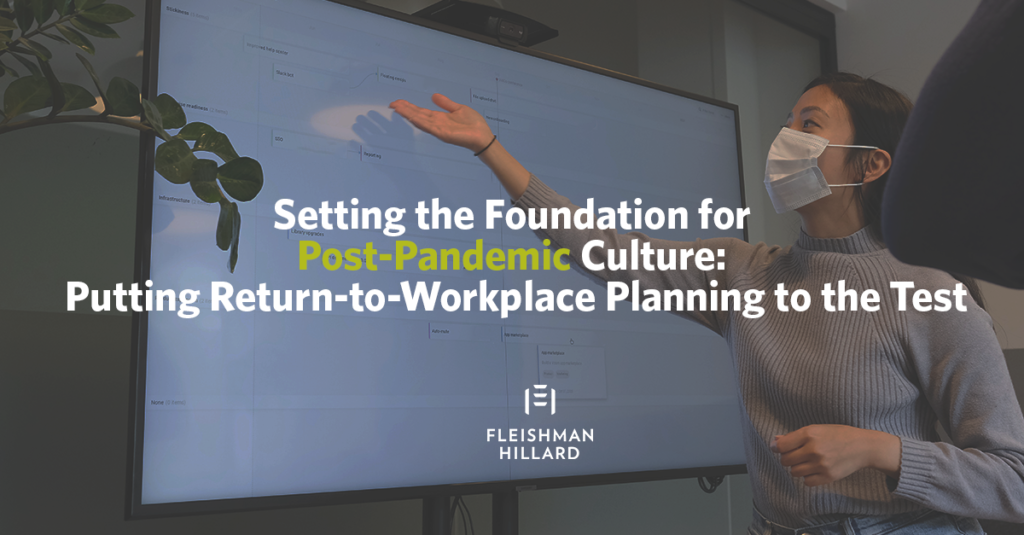Setting the Foundation for Post-Pandemic Culture: Putting Return-to-Workplace Planning to the Test
Many organizations have spent the past year preparing, planning and developing policies to support a successful return to the workplace — but planning is just the beginning. With the vaccine becoming more broadly available in many countries, COVID-19 cases declining and economies reopening, these plans are being put to the test. Now is the time to focus on what you can do to deliver a smooth experience, support employees and minimize business disruption.
MONITOR, EVALUATE AND ADJUST
As with every other phase of the pandemic, vigilance and flexibility are key. It’s important to monitor key areas as you begin welcoming more team members back to ensure measures are creating the intended result: a safe, productive work environment.
- In-office safety measures: Even as cases decline in some areas and people feel more comfortable resuming pre-pandemic activities, many people still have anxieties about the health implications of returning to workplaces. To protect employees and avoid issues, take the time to evaluate your safety and health measures.
- Pay attention to whether safety precautions are being followed and whether they’re accessible and realistic as more employees return. Consider new ways to drive accountability for these safety behaviors.
- Communicate policies and protocols clearly. If you’re taking a phased approach to return, re-communicate at the start of each phase, because employees who did not feel comfortable returning in earlier phases may not have paid close attention when the protocols were first communicated.
- Facilitate two-way dialogue to gauge feelings about safety by encouraging open doors with leadership and managers, conducting pulse surveys and offering ways for employees to ask questions and provide feedback.
- Company alignment: In the midst of your return efforts, it’s easy to get distracted by the minutiae. Take a step back and consider the larger picture: do your approach, protocols and communications align with your commitments as an organization — your mission, purpose and values?
- Throughout the process, ensure you communicate how decisions and protocols support your values and business. Take care not to value — or appear to value — business outcomes over employee well-being and safety.
COMMUNICATIONS AS PROXY FOR COMPANY CULTURE
Employers are having an especially difficult time retaining talent. Over the years, and increasingly throughout the pandemic, employees have placed increasing importance on less-tangible elements, like culture. As employees return, understand that the pandemic has changed expectations, put stress on existing culture and relationships, and introduced new challenges. As your organization and employees navigate through change and settle into the “new normal,” culture must remain an active priority.
Your communications efforts — what you communicate about and how — can reinforce or contradict the culture you want to create and sustain.
Stay Connected
Regardless of your return-to-workplace approach, focus on ensuring strong connections between employees — whether they’re back in the office, still working from home or in a hybrid model. Remind managers to regularly check in on their employees to see how they’re adjusting. Continue to use virtual meeting technologies, including video, to bring the entire team together — and give special care to your new team members to make them feel welcomed and included.
Practice Empathy
While your organization may be eager to resume in-person activities, remember that some of your employees experienced significant loss or hardship and most are returning with mixed emotions. A Limeade study found that 100% of employees had anxieties about returning — ranging from reduced flexibility to childcare solutions to safety measures.
Set the appropriate tone in your return-to-workplace communications. Focus on the positives to create optimism for the future but avoid being overly celebratory as it could turn off employees who have faced and are still facing pandemic-related challenges.
Prepare Leaders
The pandemic has challenged leaders to communicate with their teams in new ways and for many that has led to more authentic connection. Challenge leaders to continue to communicate empathetically and authentically, and to be sensitive to heightened levels of stress. Encourage them to maintain a proactive dialogue to keep their teams aware of and aligned to business priorities. Equally important, have them continue to share their life experiences and express their gratitude.
Equip Managers for the Future Environment
Managers are employees’ most trusted source of information and employees will look for their reactions on the return plan. Engage managers to gain their buy-in and provide them with tools to help communicate expectations and rationale. And because they see and hear employee sentiment first-hand, empower them to collect feedback and share it with leadership.
In hybrid work environments, managers will also face new challenges managing a dispersed team — ranging from unconscious bias toward in-person colleagues to failing to communicate with remote reports. Partner with HR or Learning Development to equip managers to lead fairly and effectively, no matter where their teams are located.
Right now, as employee support for returning greatly varies and only a small percentage want to return to a traditional office on a full-time basis, no one quite understands what a successful return to work looks like. What is known now is that employers must constantly measure and reevaluate the return as an ongoing imperative.
To ensure the ongoing safety and alignment of your employees, return-to-workplace planning must become an evolving aspect of culture, instead of a temporary corporate initiative.

